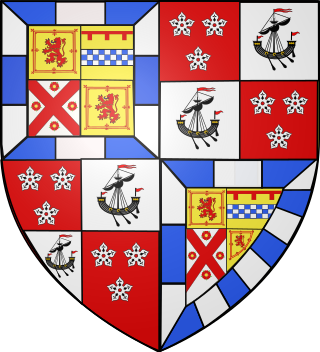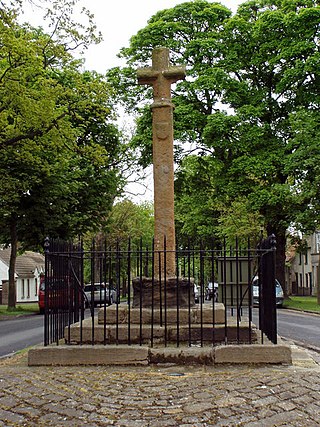Related Research Articles
John Stewart, 4th Earl of Atholl, called the Fair, was a Scottish nobleman and courtier. He was favoured by Mary, Queen of Scots, but later turned against her.

John Erskine, 1st Earl of Mar was a Scottish aristocrat and politician. He was the custodian of the infant James VI of Scotland and Regent of Scotland.
William Ruthven, 1st Earl of Gowrie, 4th Lord of Ruthven was a Scottish peer known for devising the Raid of Ruthven.
Sir Lewis Bellenden of Auchnole and Broughton was a Scottish lawyer, who succeeded his father as Lord Justice Clerk on 15 March 1577.
Robert Lauder of The Bass was an important noble in Haddingtonshire, the Merse, and Fife. Stodart remarks that "to 1600 the barons of the Bass sat in almost every parliament". He was a firm supporter of Mary, Queen of Scots whom he accompanied to Carberry Hill on 14 June 1567, and fought for at the battle of Langside.
Robert Richardson was a Scottish Prior of St Mary's Isle and royal administrator.

Captain James Stewart, Earl of Arran was created Earl of Arran by the young King James VI, who wrested the title from James Hamilton, 3rd Earl of Arran. He rose to become Lord Chancellor of Scotland and was eventually murdered in 1595.
Margaret Knox was a Scottish noblewoman and the second wife of Scottish reformer John Knox, whom she married when she was 17 years old and he 54. The marriage caused consternation from Mary, Queen of Scots, as the couple had married without having obtained royal consent.
Sir James MacGill, Lord Rankeillor of Nether Rankeillour, was a Scottish courtier and Senator of the College of Justice.

John Cockburn, laird of Ormiston, East Lothian, Scotland, was an early supporter of the Scottish Reformation. He was the eldest son of William Cockburn of Ormiston and Janet Somerville. John was usually called "Ormiston." During his lifetime there was also a laird of Ormiston in Teviotdale near Eckford, an ally of the rival Hepburn family.
Lady Agnes Stewart (1480–1557) was a Scottish noble, a cousin of King James IV of Scotland. She was born the illegitimate daughter of James Stewart, 1st Earl of Buchan and Margaret Murray. On 31 October 1552, she was legitimized under the Great Seal of Scotland.

The Cunninghams of Drumquhassle were a family of the landed gentry in Scotland from the early 16th century to the mid-17th. They are linked to the Cunninghams of Kilmaurs in Ayrshire, being descended through junior lines via the Cunninghams of Polmaise. At their greatest extent, their lands included Mugdock-Mitchell and the house at Killermont, covering the part of parishes of Strathblane and New Kilpatrick. John Cunningham, the third laird held several positions of responsibility within the Scottish court, including Master of the Royal Household for James VI and a Collector General of tax during the regency of the Earl of Lennox, but his involvement in the power struggles between the Scottish nobility and the court of Elizabeth I of England also led to his demise and he was executed for treason in 1585. Over the next century, the family lost its land and power – in the mid-17th century, the Cunninghams sold their country house in Drumquhassle in rural Stirlingshire and it passed to the Govane family.

Robert Beaton of Creich was a Scottish landowner and courtier. He served as a Master of Household to Mary, Queen of Scots.
Elizabeth Stewart, Countess of Arran was a Scottish noblewoman and political intriguer. Several accounts of her actions and ambition were written by her political enemies.
Gilbert Moncreiff was a Scottish court physician.
Walter Binning, or Bynning was a painter in 16th-century Edinburgh.
Michael Gilbert was an Edinburgh goldsmith and financier.
Barbara Hamilton was a Scottish courtier.
Janet Stewart, Lady Ruthven was a Scottish noblewoman.
Henry Echlin, Laird of Pittadro was a Scottish soldier and Constable of Edinburgh Castle during the Marian civil war. He was several times a negotiator during the "lang siege" of Edinburgh Castle. Some sources give his first name as Andrew.
References
- ↑ Robert Kerr Hannay, Rentale Sancti Andree (SHS: Edinburgh, 1913), p. 108: Accounts of the Treasurer of Scotland, 1546-1551, vol. 9 (Edinburgh, 1911), p. 436.
- ↑ Girolamo Cardano, De Rerum Varietate (Basel, 1557), Lib. 7 Cap. 37, p. 431 "vidi in capite puellae filiae Thome Tonson Edimburgi, Tertii e septuaginta circiter margaritis Scoticis, pari et insigni magnitudine".
- ↑ Robert Keith, History of the Affairs of Church and State in Scotland, vol. 1 (Edinburgh, 1734), p. 119.
- ↑ Helen Dingwall, Physicians, Surgeons and Apothecaries: Medicine in Seventeenth-century Edinburgh (Tuckwell, 1995), p. 31.
- ↑ William Baird, Annals of Duddingston and Portobello (Edinburgh: Andrew Elliot, 1898), p. 492.
- ↑ Calendar of Laing Charters (Edinburgh, 1899), pp. 158 no. 601, 217 no. 866-7, 219 no. 875.
- ↑ Jane Stewart Smith, Grange of St Giles (Edinburgh, 1898), p. 24.
- ↑ Francis James Grant, Faculty of Advocates in Scotland, 1532-1943 (Edinburgh, 1944), p. 207: Calendar of Laing Charters (Edinburgh, 1899), p. 314 no. 1284.
- ↑ Calendar of Laing Charters (Edinburgh, 1899), p. 297 no. 1203.